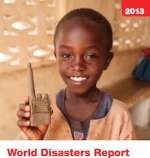 The World Disasters Report 2013 examines the profound impact of technological innovations on humanitarian action, how humanitarians employ technology in new and creative ways, and what risks and opportunities may emerge as a result of technological innovations.
The World Disasters Report 2013 examines the profound impact of technological innovations on humanitarian action, how humanitarians employ technology in new and creative ways, and what risks and opportunities may emerge as a result of technological innovations.The responsible use of technology offers concrete ways to make humanitarian assistance more effective, efficient and accountable and can, in turn, directly reduce vulnerability and strengthen resilience. Finding ways for advances in technology to serve the most vulnerable is a moral imperative; a responsibility, not a choice.
Watch the video about Technology and the future of humanitarian action on Youtube
Published annually since 1993, the World Disasters Report brings together the latest trends, facts and analysis of contemporary catastrophes and their effect on vulnerable populations worldwide. Initiated by the International Federation of Red Cross Red Crescent Societies, it convenes eminent researchers, authors and development and humanitarian aid practitioners to highlight contemporary issues on a yearly basis.
This year’s 21st edition is led by Patrick Vinck, Associate Faculty at the Harvard Humanitarian Initiative and Director of the Program for Vulnerable Populations at Harvard University, promoting evidence-based approaches to humanitarian assistance. The report is also supported by experienced researchers and practitioners, and anchored by an editorial board comprising key individuals and organizations that are actively engaged in and working with issues relevant to the theme.
According to the Centre for Research on the Epidemiology of Disasters (CRED), 364 natural disasters and 188 technological disasters were reported worldwide in 2012.
The number of natural disasters is the second lowest of the decade, while the number of technological disasters is the lowest of the decade, almost half the number for the peak year of 2005.
Find more information on the official website.
Tip: More up to date educational events dealing with “Humanitarian Aid ” can be found online on the Education Database »medicine & health«.
